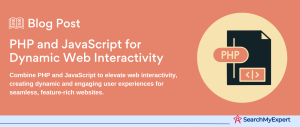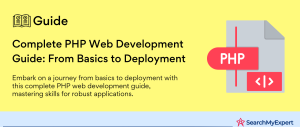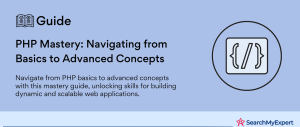PHP: Unraveling the World of Web Development
PHP, an acronym for “Hypertext Preprocessor,” stands as a beacon in the web development world. It’s an open-source, server-side scripting language that has revolutionized how dynamic web content is created and managed. But what makes PHP a language worth learning, and how does one get started with it? Let’s dive into the intricacies of PHP, from its basic structure to setting up a development environment, ensuring a comprehensive understanding for beginners and enthusiasts alike.
What is PHP?
PHP’s journey began as a simple scripting language but quickly evolved into a powerful tool for developing complex websites and applications. As an open-source language, it offers a flexible and cost-effective solution for developers. PHP is unique in its ability to seamlessly integrate with HTML, making it an indispensable asset for server-side scripting. This means the scripts are executed on the server, generating HTML which is then sent to the client’s browser, allowing for dynamic content generation that enhances user experiences.
Why Learn PHP?
- Dynamic Website Content: PHP empowers you to create web pages that interact with users, offering a personalized experience. It’s the muscle behind forums, e-commerce sites, and social networks where content changes regularly.
- Database Interactions:
PHP is incredibly adept at interacting with databases. This capability is crucial for websites that store user information, product details, and more. - Wide-Ranging Compatibility: PHP supports a wide range of databases and is compatible with various operating systems, making it a versatile choice for developers.
- Community Support: A strong, active community means a wealth of resources, tutorials, and forums are available for problem-solving and learning.
- Career Opportunities:
PHP skills are in high demand. Learning PHP opens doors to numerous opportunities in web development and related fields.
Basic Structure of a PHP File
A PHP file typically carries the “.php” extension and can contain a mix of HTML and PHP code. The basic structure includes:
- Opening and Closing Tags: PHP scripts start with <?php and end with ?>. These tags enclose the PHP code within an HTML document.
- HTML Content:
A PHP file can contain standard HTML tags, allowing for a seamless blend of server-side scripting and front-end design. - PHP Script: The actual PHP code that performs server-side tasks.
Installing and Setting Up a PHP Development Environment
To embark on your PHP development journey, setting up a proper environment is essential. Here’s a step-by-step guide:
- Choose a Development Stack: Popular options include LAMP (Linux, Apache, MySQL, PHP) for Linux, MAMP for macOS, and WAMP for Windows. These stacks include all necessary software: an operating system, web server, database system, and PHP.
- Installation:
Follow the specific installation guide for your chosen stack. This process typically involves setting up a web server (like Apache) and a database (like MySQL), along with PHP. - Configuration: Configure your environment to suit your development needs, such as setting up virtual hosts for running multiple projects or configuring database settings.
- Testing:
Create a simple PHP file to test your setup. A basic script with <?php phpinfo(); ?> can display your PHP configuration details, confirming a successful setup.
Variables and Data Types in PHP: The Building Blocks of Programming
PHP, like any programming language, uses variables and data types as fundamental components. Understanding how to declare, assign, and manipulate these variables is crucial for effective coding. Let’s explore the diverse data types in PHP and how to perform basic operations, including arithmetic, string manipulation, comparisons, and type casting.
Declaring and Assigning Variables
In PHP, a variable is declared by prefixing a dollar sign ($), followed by the name of the variable. The variable names are case-sensitive and must start with a letter or an underscore. Assigning a value to a variable in PHP is straightforward:
Types of Data in PHP
PHP is a dynamically typed language, meaning variables do not need to be declared as certain data types. However, understanding these types is crucial:
- String: A sequence of characters, used for text. Example: $name = “John Doe”;
- Integer: A non-decimal number between -2,147,483,648 and 2,147,483,647. Example: $age = 30;
- Float (or double):
A number with a decimal point or a number in exponential form. Example: $price = 10.99; - Boolean:
Represents two possible states: TRUE or FALSE. Example: $is_logged_in = true; - Array: Stores multiple values in a single variable. Example: $colors = array(“red”, “green”, “blue”);
- Object:
An instance of a class, capable of storing both values and functions. Example: $date = new DateTime(); - NULL:
Represents a variable with no value. Example: $error = NULL;
Mastering Control Flow Statements in PHP: Steering Your Code’s Direction
Control flow statements are the decision-makers in the programming world, guiding how a program executes under different conditions. In PHP, these statements are pivotal in creating dynamic and responsive applications. Let’s delve into the core aspects of control flow in PHP, covering conditional statements, loops, switch statements, and basic error-handling techniques, essential for debugging and robust code development.
Conditional Statements: If, Else, and Elseif
Conditional statements are the cornerstones of decision-making in PHP. They allow your program to execute different code blocks based on specific conditions:
- If Statement: Executes a block of code if a specified condition is true.
- Else Statement:
Executes if the condition in the if statement is false.
Looping Through Tasks
Loops are used for executing a block of code repeatedly until a certain condition is met, making them ideal for tasks that require repetition.
- For Loop:
Repeats a block of code a specific number of times. - While Loop:
Executes a block of code as long as the specified condition is true. - Do-While Loop: Executes a block of code once, and then repeats the loop as long as the condition is true.
Switch Statements: An Alternative to Multiple If Statements
When dealing with multiple conditions, a switch statement can be a cleaner alternative to numerous if-elseif statements. It compares a value against many cases and executes the matching block of code.
Functions and Arrays in PHP: Enhancing Code Efficiency and Data Management
In PHP, functions and arrays play a pivotal role in structuring code and managing data. Functions bring reusability and modularity, simplifying complex tasks into manageable blocks. Arrays, on the other hand, offer a method to store and manipulate ordered collections of data. Let’s delve into these critical aspects of PHP programming to understand how they streamline code and facilitate efficient data handling.
Functions: The Backbone of Reusable Code
Functions in PHP are the cornerstone of reusability and modularity. They allow you to encapsulate code logic that can be used repeatedly throughout your application.
- Defining Functions:
This involves creating a named block of code that performs a specific task. You define a function once and call it multiple times, reducing code redundancy. - Calling Functions:
Once defined, a function can be executed at any point in your script, promoting code reusability. This is particularly useful for tasks that need to be performed multiple times. - Functions with Arguments and Return Values:
Functions become more dynamic and flexible when they can receive inputs (arguments) and produce outputs (return values). This allows for more generic and reusable code blocks that can handle a variety of data inputs.
Arrays: Organizing and Managing Collections of Data
Arrays in PHP are essential for handling multiple data items under a single variable. They enable you to store, access, and manipulate ordered collections of data efficiently.
- Understanding Arrays:
Arrays can hold multiple values, each identified by a key. They can be numerical (indexed arrays) or associative (where each value is associated with a unique key). - Manipulating Arrays:
PHP offers a variety of functions for array manipulation, including adding, removing, and accessing elements. These functions provide the flexibility to dynamically modify the contents of an array. - Traversing Arrays: Iterating over arrays is a common task in PHP. This involves going through each element of the array, either to display the data or to perform some operation on it. PHP provides several ways to loop through arrays, each suited to different scenarios and types of arrays.
Forms and User Input in PHP: Ensuring Interactive and Secure Web Applications
Forms and user input are at the heart of interactive web applications. PHP, with its server-side capabilities, excels in handling form data, ensuring not only the functionality but also the security and integrity of the information collected. This segment focuses on creating HTML forms, accessing and validating user-submitted data, and the crucial aspects of server-side validation and sanitization to safeguard against vulnerabilities.
Creating HTML Forms for User Interaction
HTML forms are the primary method for gathering user input on the web. In PHP, these forms are designed to send data to a server for processing.
- Form Structure:
A typical HTML form includes various input elements like text fields, checkboxes, radio buttons, and submit buttons. These elements are enclosed within <form> tags. - Specifying Action and Method: The action attribute of the form determines where the data should be sent, while the method attribute (GET or POST) specifies how the data will be transmitted to the server.
Accessing and Validating Form Data Submitted by Users
Once a user submits a form, accessing and validating this data is crucial for both functionality and security.
- Accessing Data: In PHP, form data is accessed using global arrays like $_GET and $_POST, depending on the method specified in the form.
- Validation:
Validating form data ensures that the input received is as expected. This might include checking if the fields are filled out, if the data is in the correct format (like email addresses), and if the input meets specific criteria.
Server-side Validation: Ensuring Data Integrity
While client-side validation is important for a good user experience, server-side validation is critical for data integrity and security.
- Comprehensive Checks: Server-side validation involves more in-depth checks, ensuring that the data adheres to the required format, length, range, and type.
- Handling Invalid Input: When invalid data is detected, the server can respond with appropriate feedback, asking the user to correct the input.
Sanitizing User Input: A Key to Security
Sanitizing user input is vital in protecting a website from security threats like SQL injections and cross-site scripting (XSS).
- Sanitization Techniques:
PHP offers various functions to sanitize data, such as filter_var() with filters like FILTER_SANITIZE_STRING to remove potentially harmful characters. - Escaping Output:
When displaying user input or data from a database, it’s crucial to escape output to prevent XSS attacks. Functions like htmlspecialchars() convert special characters to HTML entities.
Working with Files and Databases in PHP: Managing Data and Ensuring Security
In the domain of PHP development, efficiently handling files and databases is a crucial skill. This involves reading and writing data to server files, performing database operations, and ensuring database security. Understanding these functionalities enables PHP developers to create dynamic, data-driven applications with robust and secure data management systems.
Reading and Writing Data to Files on the Server
File handling is an essential aspect of PHP, allowing for the storage and retrieval of data on the server.
- Reading Files: PHP provides functions to read content from a file, enabling you to access and display data stored on your server.
- Writing to Files:
Similarly, PHP can write data to files, useful for storing user input or generating log files.
Connecting to Databases and Basic Operations
Database interaction is a cornerstone of dynamic web applications. PHP’s ability to connect to databases and perform CRUD (Create, Read, Update, Delete) operations is fundamental.
- Database Connection:
Establishing a connection to a database is the first step. PHP typically uses PDO (PHP Data Objects) or MySQLi for connecting to MySQL databases. - CRUD Operations: Once connected, PHP can execute CRUD operations. This includes inserting new records, querying the database to retrieve information, updating existing records, and deleting records.
Storing and Retrieving Information for Dynamic Content
Dynamic content is what makes modern web applications interactive and user-friendly.
- Storing Information:
PHP can store data in a database, like user details or content submissions. - Retrieving Information: PHP scripts can query the database and retrieve data, which can then be displayed on web pages. This functionality is key in creating personalized user experiences.
Basic Concepts of Database Security
Database security is paramount in protecting sensitive information and ensuring the integrity of your web application.
- Input Validation and Sanitization:
Always validate and sanitize user input before using it in database queries to prevent SQL injection attacks. - Using Prepared Statements: Prepared statements ensure that SQL queries are securely executed, safeguarding against SQL injection.
- Access Control:
Implement robust access control mechanisms to restrict unauthorized database access.
Next Steps and Resources in PHP Development: Expanding Your Expertise
Embarking on a journey with PHP opens a plethora of opportunities for creating robust web applications. As you progress from the basics to more advanced topics, it’s crucial to access the right resources, understand best practices, and explore further the realms of PHP development. This final section aims to guide you through these advanced avenues, offering insights and tips for honing your skills and building successful PHP applications.
Additional Resources for Learning PHP
Continual learning is key in the ever-evolving world of web development. Here are some resources to deepen your PHP knowledge:
- Libraries and Frameworks:
Explore popular PHP frameworks like Laravel and Symfony. These provide structured, efficient ways to build PHP applications and offer numerous features for robust development. - Online Tutorials and Courses: Websites like Udemy, Coursera, and Codecademy offer comprehensive courses that range from beginner to advanced levels.
- Community and Forums: Platforms like Stack Overflow, GitHub, and PHP.net are invaluable for finding solutions, discussing ideas, and staying updated with the latest trends.
Best Practices for Writing Clean and Efficient PHP Code
Adhering to best practices is crucial for writing maintainable, efficient, and clean PHP code:
- Follow a Coding Standard:
Standards like PSR (PHP Standard Recommendations) ensure consistency and readability in your code. - Use Comments and Documentation: Well-documented code is easier to understand and maintain.
- Optimize Performance:
Employ efficient algorithms, and minimize resource usage to enhance application performance.
Introduction to Advanced Topics
As you become more comfortable with PHP, delving into advanced topics will further augment your development skills:
- Object-Oriented Programming (OOP):
PHP supports OOP, a paradigm that uses objects and classes, offering a more modular and reusable approach to coding. - MVC Pattern:
Understanding the Model-View-Controller (MVC) pattern is beneficial, especially when working with frameworks, as it helps in organizing code more efficiently.
Tips for Building and Deploying PHP Applications
Finally, developing your PHP application is just part of the journey. Deploying and maintaining it is equally important:
- Testing: Implement thorough testing (unit tests, integration tests) to ensure your application runs smoothly.
- Security: Prioritize security measures like using HTTPS, protecting against SQL injection, and regularly updating your PHP version.
- Deployment: Familiarize yourself with deployment tools and environments. Platforms like Heroku, AWS, or DigitalOcean offer great services for deploying PHP applications.
Conclusion
Embarking on the PHP development journey equips you with the skills to build dynamic, robust web applications. This comprehensive guide has covered the essentials, from understanding the basics of PHP, variables, control flow, and functions, to handling forms, files, and databases. Beyond these fundamentals, we delved into advanced topics such as object-oriented programming and the MVC pattern, highlighting best practices and resources for further learning.
Lead in your sector with PHP Development Service Companies.
Table of Contents
Toggle






